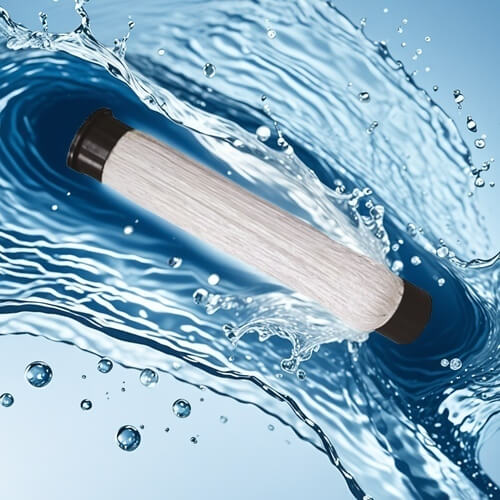Analysis and Treatment Process of Coal Chemical Wastewater
Wastewater sources: Coal chemical wastewater mainly comes from gas condensation water during coking process, washing wastewater during gas purification process, and wastewater generated during the recovery and processing of by-products such as tar and primary benzene, such as ammonia nitrogen containing wastewater generated during ammonia distillation process
Water quality characteristics:
High concentration of pollutants: including a large amount of solid particles such as coal gangue, coal slurry, and coal slag, as well as high concentration organic compounds such as coal tar, benzene, phenol, ammonia nitrogen, and difficult to degrade toxic substances such as heavy metals. The chemical oxygen demand (COD) is generally around 5000mg/l, and ammonia nitrogen is between 200-500mg/l.
Complex composition: containing various organic pollutants such as phenols, polycyclic aromatic compounds, and heterocyclic compounds containing nitrogen, oxygen, and sulfur. Among them, refractory organic compounds such as arsenic, carbazole, biphenyl, and triphenylene account for a large proportion.
Poor biodegradability: Many organic pollutants in wastewater are difficult to degrade by microorganisms and have inhibitory effects on microbial activity, leading to poor effectiveness of traditional biological treatment methods.
High chromaticity and turbidity: After biochemical treatment, the chromaticity and turbidity of wastewater are still high due to the presence of various organic compounds such as chromophores and chromophores.

Coal chemical wastewater treatment process
Preprocessing:
Oil removal: Through facilities such as oil separators, gravity separation, coalescence filtration, and cyclone separation are used to remove oil substances from wastewater, preventing oil from having adverse effects on subsequent biochemical treatment. Common oil separation equipment includes laminar flow, inclined tube, and parallel corrugated plate oil separators
Phenol removal: methods such as steam dephenolization, adsorption dephenolization, and oxidation can be used to remove phenolic substances from wastewater. For example, steam dephenolization utilizes the volatility of phenolic substances at high temperatures to separate them from wastewater
Ammonia evaporation: Using ammonia evaporation technology to remove ammonia nitrogen components from wastewater, reduce ammonia nitrogen concentration, and minimize its toxic impact on subsequent treatment processes
Removal of suspended solids: sedimentation, coagulation sedimentation and other methods are used, and coagulants such as aluminum salts, iron salts, polyaluminum, polyiron and polyacrylamide are added to form precipitates in the wastewater to remove suspended solids and reduce the impact on the biochemical system
Advanced oxidation pretreatment: Using advanced oxidation technologies such as Fenton oxidation, ozone oxidation, etc., strong oxidizing free radicals are generated to partially oxidize and decompose difficult to degrade organic matter in wastewater, improving the biodegradability of wastewater
Biochemical treatment:
A/O process: also known as anaerobic aerobic process, which utilizes the adsorption, nitrification, and denitrification of microorganisms through the alternating operation of anaerobic and aerobic sections to achieve the degradation of organic matter and removal of ammonia nitrogen. In the anaerobic stage, microorganisms decompose large molecular organic matter into small molecular organic matter, improving the biodegradability of wastewater; In the aerobic stage, further degrade organic matter and convert ammonia nitrogen into nitrate nitrogen and nitrite nitrogen
A ²/O process: Based on the A/O process, an anoxic section is added to form an anaerobic anoxic aerobic treatment process, which can simultaneously achieve phosphorus removal, nitrogen removal, and organic matter removal, improving treatment efficiency and water quality stability
SBR process: Sequential Batch Activated Sludge Process, is an activated sludge wastewater treatment technology that operates in an intermittent aeration manner. This process has the advantages of simple process flow, flexible operation mode, and good treatment effect. Through the cyclic operation of water inlet, reaction, sedimentation, drainage, and idle stages, the treatment of wastewater is achieved
UASB process: Upstream anaerobic sludge bed, wastewater flows from bottom to top through a reactor with a sludge layer at the bottom, where most organic matter is converted into CH4 and CO2 by microorganisms. This process has the advantages of high organic load, good treatment effect, and small footprint, and is suitable for the treatment of high concentration organic wastewater
Carrier fluidized bed biofilm process (CBR): It is a biofluidized bed technology based on special structured fillers, which combines biofilm process with activated sludge process. By adding special carrier fillers to the activated sludge tank, microorganisms can attach and grow on the surface of the suspended fillers, forming a microbial film layer, which improves biomass and degradation efficiency, and has a good removal effect on difficult to degrade organic matter
PACT method: Activated carbon powder is added to the activated sludge aeration tank to utilize its adsorption effect on organic matter and dissolved oxygen, providing food for microbial growth and accelerating the oxidation and decomposition ability of organic matter. At the same time, activated carbon can also adsorb difficult to degrade organic matter in wastewater, improving treatment efficiency
